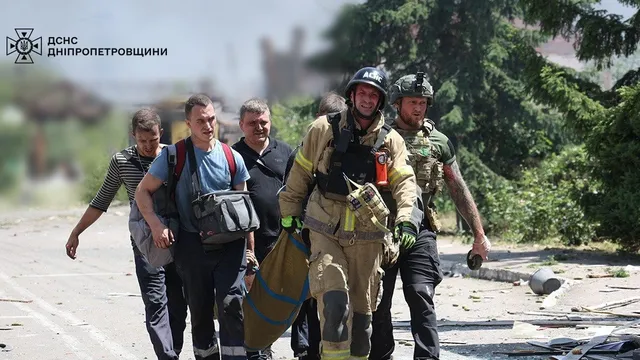
Four dead as Russia intensifies air strikes on Dnipropetrovsk
2025-06-29 22:10- On June 27, 2025, four fatalities and 17 injuries occurred due to Russian air strikes in Dnipropetrovsk.
- Evacuations are taking place as families face repeated displacements due to advancing front lines.
- The continuous military aggression underscores a dire humanitarian crisis for civilians in the region.
Express your sentiment!
Insights
In Ukraine, recent air strikes have intensified in the Dnipropetrovsk region, leading to significant civilian casualties. On June 27, 2025, four individuals lost their lives in a wave of attacks that left another 17 injured, raising concerns about safety in the area. These attacks represent the second deadly event within a week as Russian military operations aim to expand territorial control amid stalled peace negotiations. As the conflict escalates, the region, which serves as a hub for internally displaced persons, faces mounting pressures with UN human rights monitors highlighting the devastating impact on civilians. Families that have already experienced displacement are now being compelled to flee once more, particularly those near the advancing front lines across the Donetsk border. Evacuations have been mandated, particularly affecting women and children, while men are often left behind to protect property and wait for potential improvements in the situation. The atmosphere is marked by fear and uncertainty, as families like that of six-year-old Damir grapple with the emotional turmoil of leaving their homes for the second time. Amidst military actions, both sides have engaged in negotiations previously, with talks held in Istanbul, yet no tangible progress toward a cease-fire has been achieved. While minor agreements on prisoner swaps have taken place, the overarching conflict remains unresolved. This lack of meaningful dialogue exacerbates the plight of civilians, many of whom have lost their homes and livelihoods due to continuous bombardment and ground assaults. The current situation indicates an alarming trend of increased aggressiveness from Russian forces, as drone and missile strikes are more frequent and impactful. Infrastructure damage, including hospitals and schools, has raised the stakes for many in the region. Civilians express deep concern for their futures, illustrating a harrowing cycle of disruption caused by the war and the ongoing humanitarian crisis it creates.
Contexts
The history of Russian-Ukrainian peace talks is a complex narrative shaped by historical, political, and military dynamics that have evolved over time. The roots of the conflict trace back to Ukraine's independence from the Soviet Union in 1991, which marked the beginning of a strained relationship between Ukraine and Russia. Tensions escalated significantly in 2014 with Russia's annexation of Crimea and the outbreak of armed conflict in Eastern Ukraine, leading to a protracted struggle between Ukrainian forces and Russian-backed separatists. This conflict prompted the need for various peace negotiations aimed at reducing hostilities and establishing a framework for long-term stability in the region. The initial peace talks occurred under the auspices of the Organization for Security and Co-operation in Europe (OSCE), leading to the Minsk agreements in September 2014 and February 2015, which aimed to cease fire and provide a roadmap for political dialogue. However, the implementation of these agreements faced numerous challenges due to ongoing violations from both sides, as well as differing interpretations of the terms laid out in the accords. While these talks represented a critical step toward resolving the conflict, they highlighted the deep-seated mistrust between Ukraine and Russia, which has persisted throughout the years. In subsequent years, various diplomatic efforts continued, including meetings among leaders from Russia, Ukraine, France, and Germany, known as the Normandy Format. These discussions aimed to reinvigorate the peace process and bring about a resolution to the conflict. Despite some temporary agreements to reduce hostilities and exchanges of prisoners, the overall situation remained tense, with sporadic flare-ups often undermining progress. The international community, particularly the European Union and the United States, played an essential role in facilitating dialogue and imposing sanctions on Russia to apply pressure for a peaceful resolution. As the conflict endured, the humanitarian situation in affected regions worsened, prompting increasing calls for urgent humanitarian access and sustainable peace initiatives. By 2020, the emergence of new leadership in Ukraine with President Volodymyr Zelenskyy brought renewed hopes for peace talks. Zelenskyy, who campaigned on a platform of resolving the conflict, sought to engage with Russia and reinvigorate negotiations, emphasizing the need for a pragmatic approach towards finding a mutually acceptable resolution. However, the peace process encountered further complications as geopolitical tensions escalated. The global pandemic also shifted focus away from the negotiations, complicating interactions between the involved parties. Yet, attempts to reaffirm commitments to the Minsk agreements and pursue possible new frameworks continued. As of June 2025, the prospects for a durable peace remain uncertain, with ongoing hostilities and diplomatic efforts reflecting the complex interplay of local and international factors. The historical context surrounding the peace talks continues to inform current dynamics, illustrating the challenges of reconciling national sovereignty and territorial integrity amidst historical grievances and regional ambitions. Future peace efforts will require not only diplomatic negotiations but also a broader understanding of the deeply embedded issues that have driven the conflict, and a commitment from both parties to genuinely engage in a search for lasting peace.